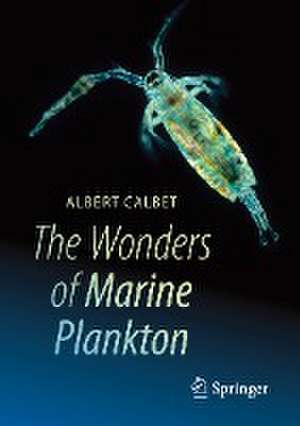The Wonders of Marine Plankton
Autor Albert Calbeten Limba Engleză Paperback – 22 feb 2024
Preț: 186.00 lei
Nou
Puncte Express: 279
Preț estimativ în valută:
35.59€ • 36.72$ • 29.70£
35.59€ • 36.72$ • 29.70£
Carte tipărită la comandă
Livrare economică 24-29 martie
Preluare comenzi: 021 569.72.76
Specificații
ISBN-13: 9783031507656
ISBN-10: 3031507657
Pagini: 157
Ilustrații: XIII, 157 p. 60 illus., 59 illus. in color.
Dimensiuni: 148 x 210 mm
Greutate: 0.23 kg
Ediția:2024
Editura: Springer Nature Switzerland
Colecția Springer
Locul publicării:Cham, Switzerland
ISBN-10: 3031507657
Pagini: 157
Ilustrații: XIII, 157 p. 60 illus., 59 illus. in color.
Dimensiuni: 148 x 210 mm
Greutate: 0.23 kg
Ediția:2024
Editura: Springer Nature Switzerland
Colecția Springer
Locul publicării:Cham, Switzerland
Cuprins
Chapter 1: A Teaspoon of Seawater: A Tiny Ecosystem.- Chapter 2: The Marine Biological Pump.- Chapter 3: The Four Seasons of Plankton.- Chapter 4: The Rhythms of Plankton.- Chapter 5: Plankton, Mussels with French Fries, and Diarrhea.- Chapter 6: Are there carnivorous plants in the sea?.- Chapter 7: The Most Formidable Predators of the Ocean: The Protists.- Chapter 8: Copepods: Good Things Come in Small Packages.- Chapter 9: Water Fleas, Matriarchy, and a Parasite Named Like a German Sausage.- Chapter 10: Gelatinous Plankton: Itchy Jellyfish, Appendicularians with Luxury Chalets, Filter Barrels, and other Extraordinary Creatures.- Chapter 11: Holoplankton and Meroplankton: two Peculiar Terms for Common Creatures.- Chapter 12: Feeding Mechanisms in Zooplankton.- Chapter 13: Evading Predators: The Clever Tactics of Plankton Survival.- Chapter 14: Bioluminescent Plankton.- Chapter 15: Global Warming and Plankton.- Chapter 16: Plankton Adaptations to Extreme Environments.- Chapter 17: The Fragility of Plankton.- Chapter 18: From Land and Sea.- Chapter 19: Plastic: you Are Plankton and to Plankton you Shall Return.- Chapter 20: Why are there no insects in the sea?.- Chapter 21: Harnessing the Power of Plankton: A Revolutionary Approach to Industry.- Chapter 22: Sampling plankton.- Chapter 23: Myths and Legends of Modern Research: Experimenting with Zooplankton.- Chapter 24: A Brief History of Plankton Discovery.
Notă biografică
Albert Calbet is a marine researcher working at the Institute of Marine Sciences, CSIC (Barcelona, Spain), specialized in the ecology and ecophysiology of micro- and mesozooplankton. He has made significant contributions to the field, particularly in understanding the role of microzooplankton in marine food webs. Albert completed his Ph.D. in Marine Sciences in 1997 at the Institute of Marine Sciences (ICM), CSIC, after which he pursued postdoctoral research at the University of Hawaii at Manoa. He has held various positions at ICM, including Deputy Director. Albert has published over 120 peer-reviewed articles, authored books and book chapters, and actively participated in scientific conferences worldwide. He has been involved in teaching and mentoring students at the Ph.D., Master, and undergraduate levels. Albert's research has been supported by prestigious institutions, and he has served as a reviewer for funding agencies and on the editorial boards of scientific journals. Committed to science outreach, he manages several Web pages and engages with the public through social media, outreach articles, and books.
Textul de pe ultima copertă
Marine plankton, despite their tiny size, are crucial for the functioning of marine food webs. It is not just about one organism eating another; when this happens, it helps release the nutrients accumulated within living matter, making them available again for microalgae. Plankton are present in freshwater and in all the seas and oceans on the planet. Moreover, they are responsible for supporting life on Earth and has provided us (on geological timescales) with a significant portion of the oxygen we breathe. In just a small spoonful of seawater, we can find around fifty million viruses, five million bacteria, hundreds of thousands of small unicellular flagellates, thousands of microscopic algae, five heterotrophic ciliates or dinoflagellates, and, with some luck, a small crustacean like copepods. This book aims to bridge the gap between scientific research and the general public, offering a captivating exploration of the fascinating world of marine plankton. Through engaging narrativesand visually compelling illustrations, readers will gain insights into the importance of plankton in marine ecosystems, their diverse forms, and the crucial role they play in maintaining our planet's health.
Caracteristici
Explains the marine ecosystem in an accessible manner Opens the door to a fascinating world unknown to the general public Unique book on the market
